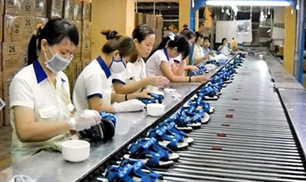Boosting exports - a viable solution
To cushion the impact of the current economic slowdown, an export-driven economy like Vietnam is advised to boost exports by expanding its outlets and capitalising on established free trade areas (FTAs).
Challenges
Major economic indicators show that the Vietnamese economy is in the doldrums, with the growth rate estimated to fall from the set target of 6-6.5 percent to 5 percent this year.
In a worrying sign of the ailing economy, more than 17,000 companies filed for bankruptcy in the first quarter of this year, causing a significant rise in unemployment. In addition, the low demand resulted in growing inventories.
Despite high growth, exports are not completely in a good light as Vietnam’s major importers are taking great pains to weather the economic storm sparked by the European debt crisis. The public debt crisis is likely to spread far and wide in Europe, which consumes a great many Vietnamese exports.
Worthy of note is that major Vietnamese exports such as
garments, footwear and seafood are vying for the lion’s share globally against
similar products from Indonesia,
Sri Lanka, Bangladesh and India,
which enjoy tax preferences from Europe. 
Opportunities
Huynh Buu Quang, an official of the Hong Kong and Shanghai Banking Corporation (HSBC) Vietnam, says although global and domestic economic difficulties are expected to affect Vietnam’s trade in the next five years, HSBC is upbeat about the country’s trade growth till 2025.
Quang explains that solid growth is achieved as Vietnam is integrating deeply into the distribution chain in the Asia-Pacific region. Vietnam has no choice at present but to ride out the economic crunch by making full use of its human resources and reform capacity.
A recent HSBC report forecasts that Vietnam’s exports to India, Brazil, Saudi Arabia and South Africa will increase considerably in the coming time. Exports to Slovakia, an important link in the supply chain of electronics and consumer goods, are expected to grow substantially.
This means Vietnamese exporters are seeking to expand outlets, besides traditional markets such as Japan, the US and Europe, to seize opportunities and avoid economic instability in Europe.
In the next five years, printing equipment, machinery and accessories are predicted to top the list of exports with an annual growth rate of 12.88 percent. They are followed by clothing and footwear exports to the US estimated at 4.41 percent per annum till 2016.
Meanwhile, Vietnam’s imports will also be on the rise, mostly from China, with oil, gas and textiles being its major imports.
An opportunity that Vietnam should grasp is to take advantage of emerging export corridors, Switzerland for instance which is a destination for Vietnamese commodities.
Support
While its traditional markets are shrinking or facing economic difficulty, Vietnam is advised to seek new outlets for its exports, and Africa, the Middle East and South America are primary targets.
This is a great challenge for Vietnamese exporters who must spend time exploring these markets, their tastes and consumer demands. This is a practical option for exporters in the coming years until domestic demand bounces back.
In their new strategies, businesses have to dig out new markets and look for financial and trade partners to successfully promote their products overseas. In this process, they can ask for support from international financial institutions that have high financial capacity, long experience and widespread networks of branches.
HSBC is a case in point. The financial group has committed US$750 billion to trade exchanges globally in 2013. In Vietnam, HSBC achieved an impressive growth rate of 17 percent in 2011 thanks to providing financial support for local import-export businesses.
Positive effects of FTAs
Joining free trade areas (FTAs) helps Vietnam not only boost exports but also receive new foreign investment flows, management skills and modern technology from developed economies. This is considered an important step towards restructuring the national economy.
Reality shows that trade lends a helping hand to an economy in crisis. The Vietnamese economy has grown and flourished with many impressive achievements since it began the Doi Moi (Renewal) process in 1986 by gradually facilitating trade liberalisation.
To make full use of the economic potential of FTAs, policymakers will have much to do, and the primary tasks are to restructure the country’s banking system, streamline administrative procedures, upgrade infrastructure, and develop human resources.
VOV

